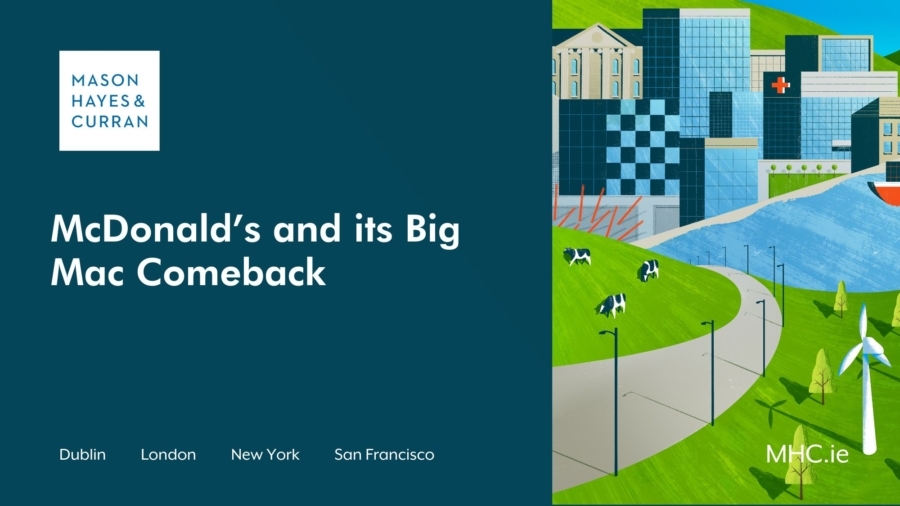McDonald’s and its Big Mac Comeback
EUIPO appeal sees previous cancellation annulled

McDonald’s have claimed back their ‘BIG MAC’ trade mark, at least partially, after successfully appealing the EUIPO’s decision to cancel its mark in its entirety. The Board of Appeal annulled EUIPO’s cancellation decision after considering supplemental evidence provided by McDonald’s in its appeal. The Board found that McDonald’s had established genuine use of its trade mark in the EU for at least some of the goods and services it had been registered for. Head of Intellectual Property, Gerard Kelly considers the many ways this case operates as a guiding principle for brand owners when it comes to proving genuine use of their trade marks.
In 2017, Supermac’s sought to obtain an EU trade mark for their Irish household name. McDonald’s caught wind of this and brought opposition proceedings against the application on the basis that the ‘Supermac’s’ mark would be confusingly similar to their ‘BIG MAC’ mark. To defend their application, Supermac’s challenged the validity of the ‘BIG MAC’ mark by filing an application for revocation for the entirety of the mark’s wide-ranging goods and services. In those proceedings, Supermac’s argued that the ‘BIG MAC’ mark was not put to genuine use for a continuous five-year period. They claimed that in no way had McDonald’s shown ‘genuine use of ‘BIG MAC’ on anything other than a sandwich including a beef patty, lettuce, cheese, pickles, onions and a special sauce.’
The Cancellation Division revoked the trade mark in its entirety, finding that the evidence was non-conclusive and the extent of the mark’s use had not been established. As McDonald’s found themselves without a registered trade mark, they no longer had a basis for their opposition. In March 2019, McDonald’s filed its appeal and proceedings kicked off in April 2022.
McDonald’s appeal
McDonald’s noted that Supermac's had acknowledged the mark was used for part of the goods it was registered for back in December 2017, and yet the mark was ultimately refused registration in its entirety. They claimed that the Cancellation Division had examined each piece of evidence in isolation and failed to consider the supporting affidavits. They stated that the affidavits confirmed that the advertising material had been used in the German, French and UK markets.
McDonald’s had also registered the mark under Class 42 for services including, restaurant services, franchising services, construction planning, and the designing of restaurants. They argued that the Big Mac was only available in McDonald’s restaurants and was therefore ‘inextricably linked to the restaurant service.’
At appeal stage, McDonald’s provided additional evidence of use, in the form of:
- Consumer surveys
- Online newspapers and magazine articles
- Evidence of the ‘Big Mac Index’ which is used to measure the purchasing power between countries
- Photos of original packaging
- Copies of receipts and excerpts from cash registers
- Screenshots of television commercial broadcasts and affidavits from employees of those advertising agencies
- Photos of adverts used on bus stops
- Advertising materials
- Menus
- YouTube videos and BBC interviews referring to the Big Mac
- Google analytic reports
- A financial audit report capturing how many units of the Big Mac were sold in Germany and the UK
- An affidavit signed by an employee of an IT company giving data on Big Mac sales online and via the McDonald’s app
- Affidavits on advertising and media expenditure, etc
Supermac’s response
Supermac’s response to the appeal primarily focused on how the additional evidence provided by McDonald’s should be rejected as it constituted a significant and substantial part of the overall evidence and was submitted without due cause at the appeal stage. They pointed out that additional evidence should only be accepted by the EUIPO if it ‘strengthens and clarifies the prior evidence submitted within the time limit.’ In any event, Supermac’s argued that the additional evidence was insufficient in providing genuine use of the mark and that no evidence had been submitted in relation to any of the contested goods or services.
Board of Appeal decision
Admissibility of evidence
In considering the admissibility of the additional evidence provided by McDonald’s, the Board found that the evidence was a reaction to the Cancellation Division’s findings. It therefore supplemented the evidence already submitted. McDonald’s had clearly indicated which pieces of additional evidence were supplementing each of the original annexes of evidence, and for what reasons. The Board considered that the conditions for accepting the additional evidence had been met.
Territorial scope of use
In considering the territorial scope covered by the evidence provided, the Board stated that it was not a requirement that the contested mark be used in a substantial part of the EU, in order for the EU mark to be deemed genuine. Instead, use in a single Member State can be sufficient to satisfy the criteria for territorial scope. Therefore, the evidence showing use in Germany, the UK, and France, fulfilled the condition that the evidence must relate to the place of use – that being the EU.
The goods and services
The Board then went on to consider the evidence as it related to each good and service listed in the mark’s specification. The Board accepted that there was evidence that the mark was used for ‘foods prepared from meat and poultry products’; ‘meat sandwiches’ and ‘chicken sandwiches’ in Class 29. Similarly, there was evidence of use for ‘edible sandwiches’; ‘meat sandwiches’ and ‘chicken sandwiches’ in Class 30 as the Big Mac brand had been used in relation to both chicken and beef burgers.
However, there was no evidence for use of the mark in relation to ‘foods prepared from pork and fish products, fish sandwiches, pork sandwiches, preserved and cooked fruits, eggs, milk, milk preparations, desserts’ in Class 29 or ‘pork sandwiches, fish sandwiches, biscuits, cakes, cookies, chocolate, coffee, coffee substitutes, tea, mustard, oatmeal, pastries, sugar’ in Class 30.
In addition, there was nothing in the evidence to suggest that the general public identified particular ingredients, such as cheese, pickles, bread and sauces, as relating to McDonald’s as the source of origin. In other words, there was no evidence of ‘Big Mac pickles’ or ‘Big Mac cheese’ etc., being in existence. Like the other ingredients, the secret Big Mac sauce is not available on the menu for individual purchase. As a result, the Board found that the mark could not be registered for the remaining goods such as sauces, cheese, pickles, breads, etc.
In considering the services registered under Class 42, the Board accepted that there were various advertising materials confirming that the Big Mac is promoted as an integral part of the McDonald’s restaurant service. Additionally, there was evidence of use of the mark for drive-through services as well as for the preparation of carry-out foods. Surveys showed that consumers automatically associated the Big Mac with the McDonald’s restaurant service. In fact, the Big Mac was identified as an ‘iconic ‘flagship’ product, intrinsically linked to ‘McDonald’s’ as it was intended to distinguish the restaurant’s services from that of others. However, the evidence failed to prove the mark was used for the remaining services such as, franchising restaurants, designing restaurants, or construction planning, etc.
The Board of Appeal found that when assessed altogether, the evidence was sufficient to show the extent of use for part of the contested goods and services. It, therefore, annulled the Cancellation Division’s decision in respect of those goods and services only.
Conclusion
This decision emphasises how important it is to provide evidence of use when faced with cancellation proceedings and/or when filing an appeal. The Board has recognised that additional evidence can be accepted at the appeal stage, provided it is supplemental to the initial evidence, or where the additional evidence would have been relevant to the outcome of the case had it been considered by the Cancellation Division on first consultation. They further acknowledged that an EU trade mark can be deemed genuine even if not used in a substantial part of the EU; use in a single Member State is sufficient.
McDonald’s provided a range of evidence in this case to prove territorial scope as well as use in relation to all of the different goods and services specified under its mark. As a result, this case operates as a great anthology for the kinds of evidence the EUIPO and its Boards of Appeal will accept when considering the genuine use of trade marks. Brands should treat this decision as a go-to guide when trying to satisfy the evidential burden of showing genuine use of a trade mark. This is particularly the case with registrations that are extensive and cover a very broad range of related goods and services. Nothing should be taken for granted!
For expert advice on successfully protecting your organisation's IP rights, contact a member of our Intellectual Property team.
The content of this article is provided for information purposes only and does not constitute legal or other advice
Share this:

